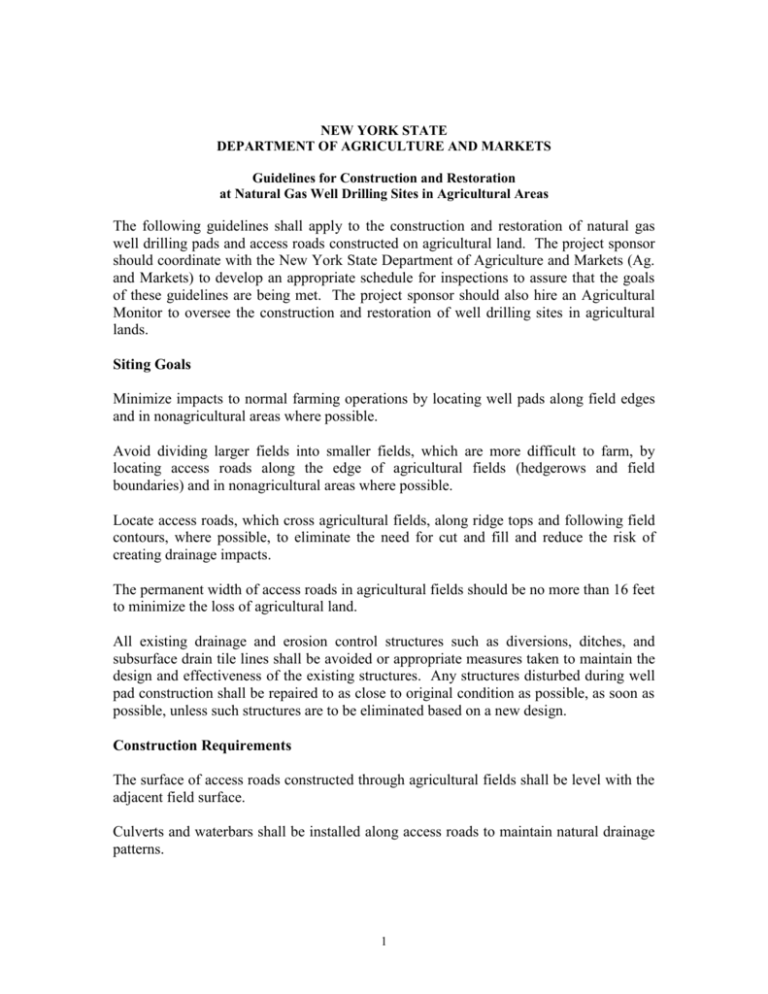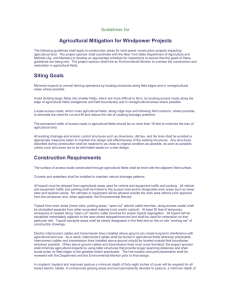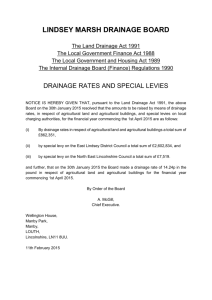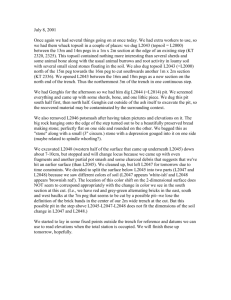Guidelines for Construction and Restoration at Natural Gas Well
advertisement

NEW YORK STATE DEPARTMENT OF AGRICULTURE AND MARKETS Guidelines for Construction and Restoration at Natural Gas Well Drilling Sites in Agricultural Areas The following guidelines shall apply to the construction and restoration of natural gas well drilling pads and access roads constructed on agricultural land. The project sponsor should coordinate with the New York State Department of Agriculture and Markets (Ag. and Markets) to develop an appropriate schedule for inspections to assure that the goals of these guidelines are being met. The project sponsor should also hire an Agricultural Monitor to oversee the construction and restoration of well drilling sites in agricultural lands. Siting Goals Minimize impacts to normal farming operations by locating well pads along field edges and in nonagricultural areas where possible. Avoid dividing larger fields into smaller fields, which are more difficult to farm, by locating access roads along the edge of agricultural fields (hedgerows and field boundaries) and in nonagricultural areas where possible. Locate access roads, which cross agricultural fields, along ridge tops and following field contours, where possible, to eliminate the need for cut and fill and reduce the risk of creating drainage impacts. The permanent width of access roads in agricultural fields should be no more than 16 feet to minimize the loss of agricultural land. All existing drainage and erosion control structures such as diversions, ditches, and subsurface drain tile lines shall be avoided or appropriate measures taken to maintain the design and effectiveness of the existing structures. Any structures disturbed during well pad construction shall be repaired to as close to original condition as possible, as soon as possible, unless such structures are to be eliminated based on a new design. Construction Requirements The surface of access roads constructed through agricultural fields shall be level with the adjacent field surface. Culverts and waterbars shall be installed along access roads to maintain natural drainage patterns. 1 All topsoil must be stripped from agricultural areas used for vehicle and equipment traffic and parking. All vehicle and equipment traffic and parking shall be limited to the access road and/or designated work areas such as well pads. No vehicles or equipment will be allowed outside the work area without prior approval from the landowner and, when applicable, the Environmental Monitor. Topsoil stockpile areas shall be clearly designated in the field and on the on-site “working set” of construction drawings. A level and stable surface is required for the drilling rig at the well site. Construction of the well pad can require significant grading of the existing surface. Topsoil should be removed from the drilling site and stockpiled separate from subsoil and other material. Topsoil and subsoil graded from the drilling site should not block natural drainage. Subsurface drainage can be damaged during the grading of the well site. Provisions for drain tile repair should be included in the easement agreement. During the drilling operation, water with a high salt content may be removed from the hole and pumped into a brine pit. Brine pits should be covered with several feet of subsoil to prevent salt damage to vegetation after reclamation. Original topsoil must be placed over the surface of the brine pit during reclamation. During the drilling, a slurry of pulverized rock and clay like material is generally removed from the hole and pumped into a pit on site. The landowner should be aware of how this mud or drill cuttings will be disposed of after drilling. Drilling mud should be removed from active agricultural fields. Drilling mud or cuttings cannot be mixed with topsoil. Farmland soils with an extended seasonal-perched high water table will sustain a chronic state of wetness throughout the mass of buried drill cuttings. The same condition may also lead to the potential leaching of residual salts within the agricultural soil profile resulting in the loss or reduction in soil fertility, and long-term crop loss. When a well pad and associated drilling operations occur on a site that has a shallow depth to the water table, alternative on-site burial techniques shall be employed. These techniques include temporary, raised earthen berm pits with plastic liner to accommodate the removal of both the drilling fluids and the wet drill cuttings from the site before restoration. In pasture areas, work areas will be fenced to prevent livestock access, consistent with landowner agreements. Restoration Requirements Following construction, all agricultural areas temporarily used for the well pad must be regraded to restore the original contours to the extent possible. After the well pad is regraded, all disturbed agricultural areas will be decompacted to a depth of 18 inches with a deep ripper (subsoiler) or heavy-duty chisel plow. In areas where the topsoil was stripped, soil decompaction shall be conducted prior to topsoil 2 replacement. Following decompaction, all rocks 4 inches and larger in size will be removed from the surface of the subsoil prior to replacement of the topsoil. The topsoil will be replaced to original depth and the original contours will be reestablished where possible. All rocks 4 inches and larger shall be removed from the surface of the topsoil. Subsoil decompaction and topsoil replacement should be avoided after October 1, unless approved on a site-specific basis by the landowner in consultation with Ag. and Markets. All parties involved should be cognizant that areas restored after October 1st may not obtain sufficient growth to prevent erosion over the winter months. If areas are to be restored after October 1st, necessary provision should be made to restore any eroded areas in the springtime, to establish proper growth. Where farmland on a soil with a high water table has been inadvertently used as a disposal pit for the wet drill cuttings and potential residual salts, the site can be rehabilitated for farming by the re-excavation of the pit, removal of the materials, and subsequent backfilling with soil materials that is consistent with the native soil profile. All access roads will be regraded to allow for farm equipment crossing and to restore original surface drainage patterns, or other drainage pattern incorporated into the design. Lime and fertilizer shall be applied to restored agricultural areas where necessary and such areas shall be seeded with the seed mix specified by the landowner, in order to maintain consistency with the surrounding areas. All surface or subsurface drainage structures damaged during construction shall be repaired to as close to preconstruction conditions as possible, unless said structures are to be removed as part of the project design. Any surface or subsurface drainage problems resulting from construction of the well pad will be corrected with the appropriate mitigation as determined by the Agricultural Monitor, The Department and the Landowner. Following restoration, all construction debris will be removed from the site. Two Year Monitoring and Remediation The Project Sponsor will provide a monitoring and remediation period of no less than two years immediately following the completion of initial restoration. The two year period allows for the effects of climatic cycles such as frost action, precipitation and growing seasons to occur, from which various monitoring determinations can be made. The monitoring and remediation phase will be used to identify any remaining agricultural impacts associated with construction that are in need of mitigation and to implement the follow-up restoration. General conditions to be monitored include topsoil thickness, relative content of rock and large stones, trench settling, crop production, drainage and repair of severed fences, etc. 3 Impacts will be identified by the Environmental Monitor through on site monitoring of all agricultural areas impacted by construction and through contact with respective farmland operators and the Department of Agriculture and Markets. Monitoring and follow-up should include any necessary mitigation of residual drainage problems with effective installation of AASHTO M252 subsurface drain line systems along the perimeter of the overall site and “horseshoed” around and slightly upslope from the burial pit. Topsoil deficiency and settling shall be mitigated with imported topsoil that is consistent with the quality of topsoil on the affected site. Excessive amounts of rock and oversized stone material will be determined by a visual inspection of disturbed areas as compared to portions of the same field located outside the construction area. All excess rocks and large stones will be removed and disposed of by the Project Sponsor. When the subsequent crop productivity within affected areas is less than that of the adjacent unaffected agricultural land, the Project Sponsor as well as other appropriate parties, will help to determine the appropriate rehabilitation measures to be implemented. Because conditions which require remediation may not be noticeable at or shortly after the completion of construction, the signing of a release form prior to the end of the remediation period will not obviate the Project Sponsor’s responsibility to fully redress all project impacts. Subsoil compaction shall be tested using an appropriate soil penetrometer or other soil compaction measuring device. Compaction tests will be made for each soil type identified on the affected agricultural fields. The subsoil compaction test results within the affected area will be compared with those of the adjacent unaffected portion of the farm field/soil unit. Where representative subsoil density of the affected area exceeds the representative subsoil density of the unaffected areas, additional shattering of the soil profile will be performed using the appropriate equipment. Deep shattering will be applied during periods of relatively low soil moisture to ensure the desired mitigation and to prevent additional subsoil compaction. Oversized stone/rock material which is uplifted to the surface as a result of the deep shattering will be removed. 4







